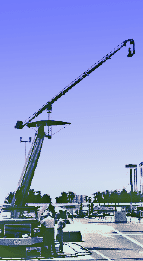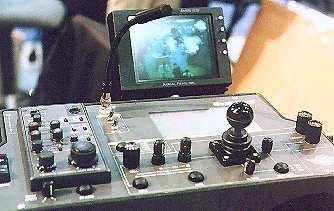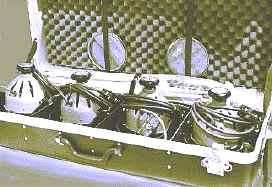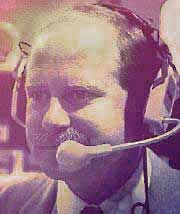|
Module 61 |
Updated: 08/30/2005 |
|
Multiple-Camera Remotes
The most challenging, exciting, and demanding productions to do are multiple-camera remotes-especially if they are done live. Live productions such as the Super Bowl and the Academy Awards may require 30 or more cameras, a few tons of equipment, and months of preparation. But even covering a high-school football game or a homecoming parade with just a couple cameras takes skills beyond those needed for a basic studio production. In the studio you have a tested, controlled, and even predictable environment. Once you leave the studio, things can get much more complex. One of the most important step in doing a successful remote production is the first one: doing a thorough on-location survey. |
|
The On-Location Survey Although situations vary, an initial survey for a major, multiple-camera field production typically includes at least 10 points or questions. (Again, we are starting off by thinking big. These elements will need to be scaled down for smaller remotes.) 1. A check of available power. What will your total power needs be in terms of watts or amps on the location? Does the remote van that will house your production equipment take 120- or 220-volt power? Is there enough power on the location? Will long power lines have to be run to bring in adequate power? Is a portable generator the only solution? 2. If it's a live production,
does the location provide for a clear
3. Will there be sound problems? Is there a street nearby where noisy motorcycles or trucks can cause audio problems? Depending on changing wind conditions, is it possible that a location may end up being in the flight path of an airport? If the production is being done inside, will the acoustics present audio problems? 4. What are the existing lighting conditions? Will extra lights have to be set up? And if so, will the air conditioning be able to handle the resulting heat? If the shoot is exterior, where will the sun be during the scheduled time of the shoot? Will deep shadows caused by the position of the sun require reflectors or high-powered fill lights? 5. What
changes will be necessary at the location to accommodate the script, talent, and
production equipment? Will existing
signs have to be removed or covered to preserve authenticity in a dramatic production?
This is especially important in period pieces that are set in specific historic
eras. Could you have a scene with Albert Einstein using a ball-point pen, or living in a house with stucco walls? Savvy audiences are quick to pick up on these things. In addition, you may have to make changes at the site to accommodate cameras and equipment. 6. What are the restrictions involved in using the location? Some communities, especially in Southern California, Miami, Chicago, and New York City, have strict guidelines covering production locations, hours, and conditions. Special permits, insurance, and security bonds are required. Even students doing productions for class have run into problems with local officials. 7. Can a contract be drawn up to ensure that you will have the facilities as long as you need them? Without putting things in writing, there can be misunderstandings. You might want to specify such things as:
8. Does the location offer adequate toilet facilities for cast and crew? Are they readily available (as would normally be the case in a large athletic facility) or will portable facilities have to be rented? 9. Will adequate security, police, and first aid be available? If equipment is to be left overnight, will security guards have to be hired? Will off-duty police have to be hired to keep onlookers from interfering with the production? 10. Are there nearby restaurants, or will a catering service have to be brought in? Nearby restaurants may not be able to handle a large crew within the time allotted for lunch or dinner.
To show the camera positions decided upon by the director, a location sketch is generally attached to the facilities request form discussed in Module 59. When deciding on camera locations, several things should be kept in mind. In addition to the obvious things, such as not shooting against the sun and not placing a camera in a position that would result in a reversal of action (crossing the line), there are some special considerations for stationary cameras. If people suddenly jump up in front of your camera during the most exciting play in a game and block your shot, there may be little you can do. Members of the press or ENG camerapersons may find that the camera positions you've selected are ideal, which wouldn't be surprising if they are good ones. If they don't stand directly in front of your camera, they may simply block your shot from one or more angles. And, there is another problem you may need to anticipate. If fans or spectators start jumping up and down in their excitement and shaking the camera platform, the resulting video may be unusable. If the budget allows, you might want to consider renting a camera jib (pictured below on the left) to add some dynamic camera moves to your production (and shoot over the head of anyone that could be in the way of your camera shots). Below you can also see the remote control unit for a jib or crane-mounted camera.
Finally, in order to hold public relations problems to a minimum, you will need to make sure that your cameras, lights, or other equipment don't block the view of individuals who have paid to attend the event.
Because of the noise common to remote locations, off-camera directional mics or personal wireless mics are almost always used on remotes. In the latter case, be sure to check for multipath reception and dead spots by having an assistant test each RF mic while talking and slowly walking through the area where it will be used. Since mic problems are common, back-up mics that can be put into service at a moment's notice should be provided for each area. When mounting crowd mics (mics that will pick up audience or crowd reaction) make sure they cover a wide area, rather than favoring a few people closest to a mic. Plan for the shortest distances possible for mic cables and avoid running them parallel to power cords where electrical noise might be induced into an audio line. In wet weather tightly seal up cable connectors with black plastic electrical tape.
Once the lighting director visits
the location, a list of needed As we've noted, you need to check the sun's location during the time scheduled for the shoot. Pay particular attention to resulting shadows. And, finally, have a "lighting plan B" (along with a production Plan B) worked out, in case it rains.
In a regular studio production, crew members typically get to know the basic routines associated with programs and often don't even have to be prompted by the director. But, during a field production routines change and crew members will depend heavily on the director for second-by-second cues. To maintain microwave or satellite signals at optimum technical quality, engineers at both ends of the remote link must be in contact so that video and audio level adjustments can be made. Except in the case of some microwave and satellite feeds that accommodate PL audio channels, cell phones or land lines may have to be used by engineering and production personnel to keep in touch with the station or production facility. Production personnel at both ends of the link must be able to coordinate commercials and station breaks. These normally originate from video servers or videotape at the station. Interruptible feedback (IFB) lines
are used to communicate with In their normal mode, one or both earphones carry program audio. When a brief message needs to be relayed to an announcer (preferably when he or she is not talking) the audio on just one of the earphones can be interrupted for the message. A director may need to notify an announcer to go to a commercial, for example, or tell a color commentator that a replay of a specific play is ready for playback. Although PL headsets are generally plugged into cameras, in some cases extra PL line drops (added outlets) have to be installed in field locations to accommodate production personnel who are not working close to a camera. And, of course, maximum mobility is possible if these crew members use wireless PL systems. Because of the importance of PL communication, it's highly desirable-some would say absolutely essential in live broadcasts-to have a fully-functional standby (backup) PL line that everyone can instantly switch to if problems develop in the primary system.
The remote survey form and facilities request form should be used as a guide in deciding on the production equipment that will be transported to the remote location. An equipment list should be carefully drawn up and then double-checked as the equipment is packed. Don't forget extra lamps for lights, extra mics and mic cords, extra headsets, etc. It's a rare remote in which some piece of equipment doesn't fail. |

 satellite
uplink or microwave path? Productions are not transmitted to viewers
directly from the field; instead, they must first be sent to a TV station or a production
facility and then to a transmitter or head-end distribution point. A signal can
be sent from the field by:
satellite
uplink or microwave path? Productions are not transmitted to viewers
directly from the field; instead, they must first be sent to a TV station or a production
facility and then to a transmitter or head-end distribution point. A signal can
be sent from the field by: A dramatic production set in the era depicted by this scene, for example, would
have to undergo extensive scrutiny to eliminate items and materials that were
not available during this era.
A dramatic production set in the era depicted by this scene, for example, would
have to undergo extensive scrutiny to eliminate items and materials that were
not available during this era. 

 lighting
instruments and accessories can be drawn up. One or more lighting
kits, such as the one shown here, may be needed.
lighting
instruments and accessories can be drawn up. One or more lighting
kits, such as the one shown here, may be needed. on-camera
talent. Unlike live ENG reporters who wear only a small, single IFB ear piece, announcers
for sports events generally prefer padded, noise-canceling earphones that cover
both ears.
on-camera
talent. Unlike live ENG reporters who wear only a small, single IFB ear piece, announcers
for sports events generally prefer padded, noise-canceling earphones that cover
both ears.